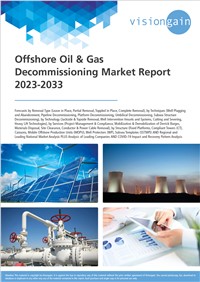The Offshore Oil & Gas Decommissioning Market Report 2023-2033: This report will prove invaluable to leading firms striving for new revenue pockets if they wish to better understand the industry and its underlying dynamics. It will be useful for companies that would like to expand into different industries or to expand their existing operations in a new region.
The Management and Decommissioning of Obsolete Oil & Gas Infrastructure Is an Excellent Opportunity
Offshore structures used in the oil and gas industry include production platforms, drilling rigs, floating production, storage, and offloading units (FPSO), floating storage units (FSU), and others. The geographic location of hydrocarbon deposits, which dictates the position of drilling rigs and offshore structures, is an important consideration in the oil and gas industry. Because hydrocarbon deposits are found in highly diverse and often technically challenging locations, it is more or less inevitable that technical solutions to develop resources are tailored to some extent, and the design of any offshore structure is almost always, in some ways, unique to the location.
The management and decommissioning of obsolete oil and gas infrastructure is an excellent opportunity to investigate how environmental concerns are balanced against economic realities, and whether society has access to adequate scientific data to support management decisions. To achieve the best results, decisions on the timescale, methodology, and monitoring of decommissioning must be supported by sound environmental data. The main challenge is to collect, collate, and interpret the necessary data at appropriate spatial and temporal scales across the North Sea in order to make informed decisions. The North Sea is a resource shared by Belgium, Denmark, France, Germany, the Netherlands, Norway, and the United Kingdom. These states include a portion of the North Sea in their territorial waters, and other EU Member States have claims to its resources.
What Questions Should You Ask before Buying a Market Research Report?
- How is the offshore oil & gas decommissioning market evolving?
- What is driving and restraining the offshore oil & gas decommissioning market?
- How will each offshore oil & gas decommissioning submarket segment grow over the forecast period and how much revenue will these submarkets account for in 2033?
- How will the market shares for each offshore oil & gas decommissioning submarket develop from 2023 to 2033?
- What will be the main driver for the overall market from 2023 to 2033?
- Will leading offshore oil & gas decommissioning markets broadly follow the macroeconomic dynamics, or will individual national markets outperform others?
- How will the market shares of the national markets change by 2033 and which geographical region will lead the market in 2033?
- Who are the leading players and what are their prospects over the forecast period?
- What are the offshore oil & gas decommissioning projects for these leading companies?
- How will the industry evolve during the period between 2023 and 2033? What are the implications of offshore oil & gas decommissioning projects taking place now and over the next 10 years?
- Is there a greater need for product commercialisation to further scale the offshore oil & gas decommissioning market?
- Where is the offshore oil & gas decommissioning market heading and how can you ensure you are at the forefront of the market?
- What are the best investment options for new product and service lines?
- What are the key prospects for moving companies into a new growth path and C-suite?
You need to discover how this will impact the offshore oil & gas decommissioning market today, and over the next 10 years:
- Our 390-page report provides 165 tables and 204 charts/graphs exclusively to you.
- The report highlights key lucrative areas in the industry so you can target them – NOW.
- It contains in-depth analysis of global, regional and national sales and growth.
- It highlights for you the key successful trends, changes and revenue projections made by your competitors.
This report tells you TODAY how the offshore oil & gas decommissioning market will develop in the next 10 years, and in line with the variations in COVID-19 economic recession and bounce. This market is more critical now than at any point over the last 10 years.
Forecasts to 2033 and other analyses reveal commercial prospects
- In addition to revenue forecasting to 2033, our new study provides you with recent results, growth rates, and market shares.
- You will find original analyses, with business outlooks and developments.
- Discover qualitative analyses (including market dynamics, drivers, opportunities, restraints and challenges), cost structure, impact of rising offshore oil & gas decommissioning prices and recent developments.
This report includes data analysis and invaluable insight into how COVID-19 will affect the industry and your company. Four COVID-19 recovery patterns and their impact, namely, “V”, “L”, “W” and “U” are discussed in this report.
Segments Covered in the Report
Market Segment by Removal Type
- Leave in Place
- Partial Removal
- Toppled in Place
- Complete Removal
Market Segment by Techniques
- Well Plugging and Abandonment
- Pipeline Decommissioning
- Platform Decommissioning
- Umbilical Decommissioning
- Subsea Structure Decommissioning
Market Segment by Technology
- Jackside & Topside Removal
- Well Intervention Vessels and Systems
- Cutting and Severing
- Heavy Lift Technologies
Market Segment by Services
- Project management & Compliance
- Mobilization & Demobilization of Derrick Barges
- Materials Disposal
- Site Clearance
- Conductor & Power Cable Removal
Market Segment by Structure
- Fixed Platforms
- Compliant Towers (CT)
- Caissons
- Mobile Offshore Production Units (MOPU)
- Well Protectors (WP)
Subsea Templates (SSTMP)




